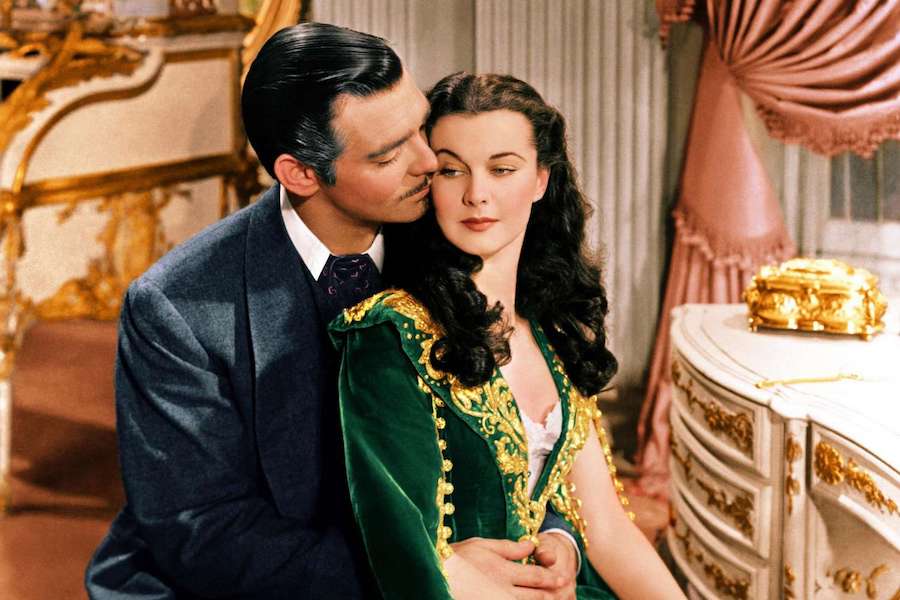
THE GREATEST ROMANCE OF ALL TIME!

Last August, news came that a cinema in Memphis, Tennessee had decided not to screen Gone With the Wind because of numerous complaints. Ever since its premiere the film’s rosy portrait of life in the South before the Civil War has been criticized. The poor treatment of African-Americans has been a constant theme. The novel and the movie refused to portray slaves honestly, and even when Hattie McDaniel became the first Black actor to be nominated and win the Oscar, segregation prevented her from sitting with her white co-stars at the Academy Awards.
Still, Gone With the Wind should not be banned, it should be seen. Partly because it is a cinematic masterpiece, partly because what happens in it (and the attitudes of 1939 America) should be a topic of discussion, not swept under a rug.
Eagerly anticipating a war
Georgia, 1861. The South is full of young men who are eagerly anticipating war with the North. Rhett Butler (Clark Gable), a visitor of ill repute from Charleston, realizes how poorly prepared the South is and, while attending an engagement party at a plantation, quickly makes enemies. He is spotted by Scarlett O’Hara (Vivien Leigh) who is instantly disgusted and fascinated by him. This is not a good time for her, because she had set her eyes on the man who’s about to get married, Ashley Wilkes (Leslie Howard), but he fell in love with her cousin Melanie (Olivia de Havilland). When Scarlett desperately tries to change Ashley’s mind one last time but is rebuffed, she’s mortified to learn that Rhett overheard everything. Over the following years, through war, misery and heartache, Scarlett and Rhett can’t escape each other…
A tumultuous production
The story of the making of this blockbuster is almost equally epic, all of it breathlessly captured by the newspapers at the time. Producer David O. Selznick bought the rights to Margaret Mitchell’s schmaltzy novel and spent a few years trying to find the right actors to play Rhett and especially Scarlett. Eventually, Leigh was chosen for the latter and it made her career.
The gorgeous Technicolor cinematography still takes one’s breath away, and so do the opulent production design and costumes
The production became tumultuous because of several rewrites and the fact that Selznick fired George Cukor as director after three weeks. Victor Fleming, who was also making The Wizard of Oz at the time, was brought on board, but suffered from exhaustion; another director, Sam Wood, replaced him for a while. In short, there was chaos at times. But look at the results. The gorgeous Technicolor cinematography still takes one’s breath away, and so do the opulent production design and costumes. Max Steiner’s now classic music score has an unforgettable theme. The story, where no one seems to get what they really want, has enough drama to overcome a few lulls in the second half of a very long movie; its most riveting moments are perfectly staged.
Gable has the right irreverent approach to Rhett Butler, and McDaniel makes the most of her every scene as she tries to turn Scarlett into a respectable woman.
In the end, the film belongs primarily to Scarlett O’Hara. It’s her journey that we’re following, and it’s not a pretty one. There’s a reason why it takes Rhett so long to finally say ”Frankly my dear, I don’t give a damn”. Scarlett is a spoilt belle, unable to successfully handle her love for Ashley and Rhett. It’s a complex character that Leigh has immortalized in amusing and infuriating ways; we can’t take our eyes off of her. She has come to symbolize everything that’s wrong with the Old South, including the false façade of dignity in a society that thrives because of slavery. Her suffering and how that leads to maturity during the war makes us root for her.
Gone With the Wind 1939-U.S. 222 min. Color. Produced by David O. Selznick. Directed by Victor Fleming. Screenplay: Sidney Howard. Novel: Margaret Mitchell. Cinematography: Ernest Haller. Music: Max Steiner. Editing: Hal C. Kern, James E. Newcom. Production Design: William Cameron Menzies. Art Direction: Lyle R. Wheeler. Costume Design: Walter Plunkett. Cast: Clark Gable (Rhett Butler), Vivien Leigh (Scarlett O’Hara), Leslie Howard (Ashley Wilkes), Olivia de Havilland, Thomas Mitchell, Barbara O’Neil, Hattie McDaniel… Harry Davenport, Ann Rutherford, Ward Bond, Jane Darwell, George Reeves.
Trivia: Alternative running time: 233 min. Gary Cooper was considered as Rhett Butler; Tallulah Bankhead, Norma Shearer, Jean Arthur and Joan Crawford as Scarlett. Followed by a miniseries, Scarlett (1994).
Oscars: Best Picture, Director, Actress (Leigh), Supporting Actress (McDaniel), Screenplay, Cinematography, Film Editing, Art Direction (the film also won two additional awards at the Oscars, one for Menzies and another for technical achievements).
Quote: “As God is my witness, as God is my witness, they’re not going to lick me! I’m going to live through this and when it’s all over, I’ll never be hungry again! No, nor any of my folk. If I have to lie, steal, cheat or kill! As God is my witness, I’ll never be hungry again!” (Leigh)
Last word: “When I arrived at David Selznick’s office for the contract signing, Vivien was already present and seated with David not far from his desk. As I came through the doorway, Vivien rose and crossed the room to shake my hand. I thought this was extremely gracious of her. I would say that her bearing then was rather stately; later, she became almost as young in manner as the 18-year-old Scarlett!” (de Havilland, VivandLarry.com)
